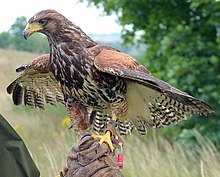Harris's Hawk
| Harris's Hawk | |
|---|---|
 | |
| Conservation status | |
| Scientific classification | |
| Kingdom: | Animalia |
| Phylum: | Chordata |
| Class: | Aves |
| Order: | Accipitriformes |
| Family: | Accipitridae |
| Subfamily: | Buteoninae |
| Genus: | Parabuteo Ridgway, 1874 |
| Species: | P. unicinctus |
| Binomial name | |
| Parabuteo unicinctus (Temminck, 1824) | |
| Subspecies | |
P. u. harrisi
P. u. superiorP. u. unicinctus | |
The Harris's Hawk or Harris Hawk (Parabuteo unicinctus) formerly known as the Bay-winged Hawk or Dusky Hawk, is a medium-large bird of prey which breeds from the southwestern United States south to Chile and central Argentina. Birds are sometimes reported at large in Western Europe, especially Britain, but it is a popular species in falconry and these records almost certainly all refer to escapes from captivity.
It is the only member of the genus Parabuteo. The name is derived from the Greek para, meaning beside, near or like, and the Latin buteo, referring to a kind of buzzard; uni meaning once; andcinctus meaning girdled, referring to the white band at the tip of the tail. John James Audubongave this bird its English name in honor of his ornithological companion, financial supporter, and friend Edward Harris.The Harris Hawk is notable for its behavior of hunting cooperatively in "packs", consisting of family groups while most other raptors hunt in solitary.
Description
Individual Harris Hawks range in length from 46 to 76 cm (18 to 30 in) and generally have a wingspan of about 1.1 m (3.6 ft)They exhibit sexual dimorphism with the females being larger by about 35%. In the United States, the average weight for males is about 710 g (25 oz), while the female average is 1,020 g (36 oz).They have dark brown plumage with chestnut shoulders, wing linings, and thighs, white on the base a tip of the tail,long, yellow legs and a yellow cere. The vocalizations of the Harris's Hawk are very harsh sounds.
Juvenile
The juvenile Harris Hawk is mostly streaked with buff, and appears much lighter than the dark adults. When in flight, the undersides of the juveniles' wings are buff-colored with brown streaking. They can look unlike adults at first glance, but the identical chestnut plumage is an aid for identification.
Subspecies
There are three subspecies of Harris's Hawk:
- P. u. superior: found in Baja California, Arizona, Sonora, and Sinaloa. P. u. superior was believed to have longer tails and wings and to be more blackish than P. u. harrisi. However, the sample size of the original study was quite small, with only five males and six females. Later research has concluded that there is not as strong a physical difference as was originally assumed. Other ecological differences, such as latitudinal cline were also brought up as arguments against the validity of the subspecies segmentation.
- P. u. harrisi: found in Texas, eastern Mexico, and much of Central America.
- P. u. unicinctus: found exclusively in South America. It is smaller than the North American subspecies.
Distribution and habitat
Harris's Hawks live in sparse woodland and semi-desert, as well as marshes (with some trees) in some parts of their range (Howell and Webb 1995), including mangrove swamps, as in parts of their South American range.Harris's Hawks are permanent residents and do notmigrate.
Behavior
Feeding
The diet of the Harris's Hawk consists of small creatures including birds, lizards, mammals, and large insects. Because it often hunts in groups, the Harris's Hawk can also take down larger prey, such as jackrabbits.
Breeding
They nest in small trees, shrubby growth, or cacti. The nests are often compact, made of sticks, plant roots, and stems, and are often lined with leaves, moss, bark and plant roots. They are built mainly by the female. There are usually two to four white to blueish white eggs sometimes with a speckling of pale brown or gray. The nestlings start out light buff, but in five to six days turn a rich brown.
Very often, there will be three hawks attending one nest: two males and one female.Whether or not this is polyandry is debated, as it may be confused with backstanding (one bird standing on another's back). The female does most of the incubation. The eggs hatch in 31 to 36 days. The young begin to explore outside the nest at 38 days, and fledge, or start to fly, at 45 to 50 days. The female sometimes breeds two or three times in a year.Young may stay with their parents for up to three years, helping to raise later broods.
Relationship with humans
Hunting
While most raptors are solitary, only coming together for breeding and migration, Harris's Hawks will hunt in cooperative groups of two to six. This is believed to be an adaptation to the desert climate in which they live. In one hunting technique, a small group flies ahead and scouts, then another group member flies ahead and scouts, and this continues until prey is bagged and shared. In another, all the hawks spread around the prey and one individual flushes it.
The wild Harris's Hawk population is declining due to habitat loss; however, under some circumstances, they have been known to move into developed areas.
Falconry
Since about 1980, Harris's Hawks have been increasingly used in falconry and are now the most popular hawks in the West (outside of Asia) for that purpose, as they are the easiest to train and the most social.
In art
John James Audubon illustrated the Harris's Hawk in Birds of America (published, London 1827–38) as Plate 392 with the title "Louisiana Hawk -Buteo harrisi". The image was engraved and colored by the Robert Havell, London workshops in 1837. The original watercolor by Audubon was purchased by the New York History Society where it remains to this day (January 2009).






No comments:
Post a Comment